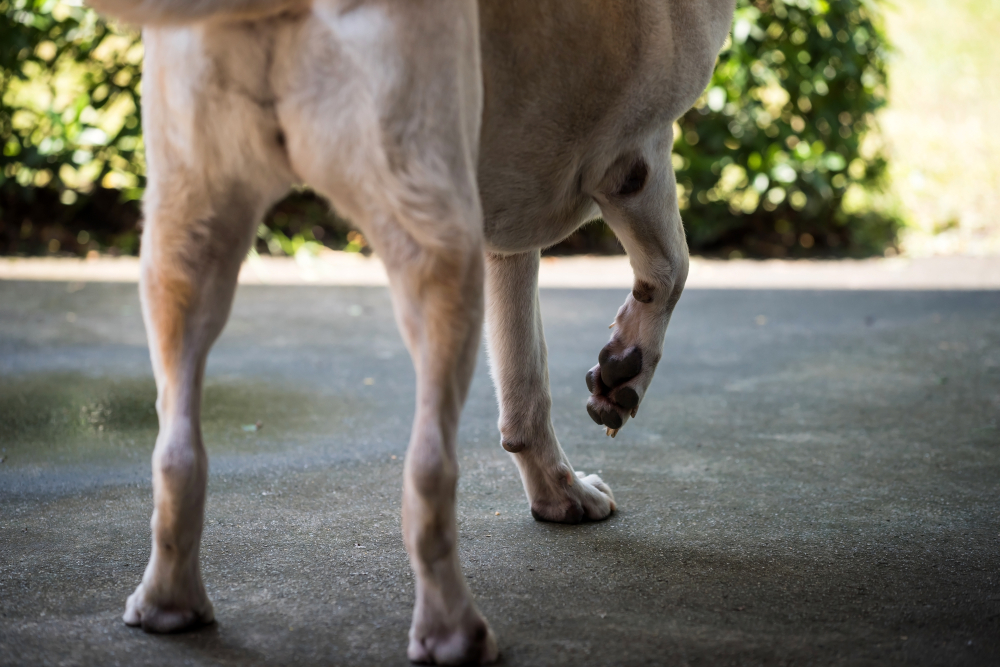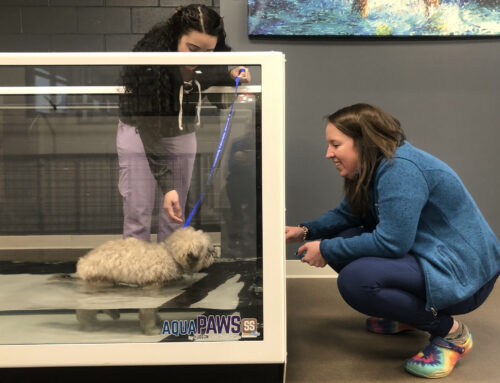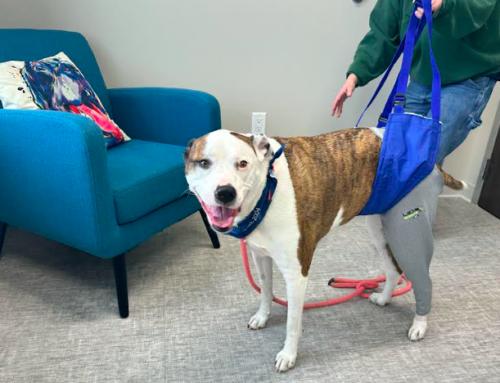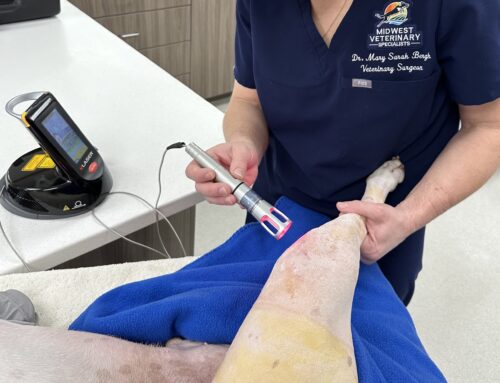Many conditions can cause your pet to start limping, and some issues are more concerning than others. Our team at Midwest Veterinary Specialists wants to help by providing information about what conditions cause pets to limp, how these problems are diagnosed and managed, and when you should seek veterinary care.
Lameness detection in pets
Dogs and cats bear less weight than normal on a limb (i.e., limp) when there is pain somewhere in the leg. Sometimes, in severe cases, a pet will hold up the painful limb and not put any weight on it, making detecting the problematic leg easy. In less obvious cases, however, it may be more difficult to determine which limb hurts. Here are some tips that can help identify lameness in your pet:
- Front limb lameness — If your pet has a painful front limb, they will raise their head when the sore leg touches the ground, and lower their head when bearing weight on the good leg. A good reminder is, “down on sound.” In other words, when your pet is walking and his head goes down, look at which front foot is on the ground—that will be the sound (i.e., non-painful) leg.
- Hind limb lameness — If your pet has a painful hind limb, they typically will lean forward to take weight off their back end, and the hip on the side of the painful leg will rise when the painful leg touches the ground. This is sometimes called a “hip hike.”
- Multiple limb lameness — If your pet has more than one painful limb, they may appear stiff all over, exhibit an awkward gait, or be reluctant to move at all.
Lameness causes in pets
Many different conditions can cause your pet to limp. Some of these include:
- Bone fractures — Fractures tend to cause significant lameness and can affect any bone.
- Ligament sprains — Similar to humans, pets can experience soft tissue injuries, such as sprains and strains.
- Wounds — Wounds on your pet’s limb can cause pain and lameness.
- Torn nails — Nail issues, such as ingrown nails and torn nails, can be painful, resulting in lameness.
- Tick-borne illnesses — Diseases, such as Lyme disease, ehrlichiosis, and anaplasmosis, can cause joint inflammation and pain, resulting in lameness.
- Cancer — Cancers affecting soft tissues, bones, or joints can cause your pet to limp.
- Arthritis — Arthritis is a common condition that can affect most joints in cats and dogs, leading to discomfort and lameness.
- Infection — A bacterial or fungal infection affecting soft tissues, bones, or joints can cause lameness.
- Elbow dysplasia — This condition is an inherited, developmental disorder that causes abnormal growth and subsequent arthritis in the elbow. Large- and giant-breed dogs are most commonly affected, and Bernese mountain dogs, German shepherds, Labrador retrievers, and golden retrievers are at higher risk.
- Shoulder osteochondrosis dissecans (OCD) — Shoulder OCD is common in rapidly growing, immature large- and giant-breed dogs. The condition occurs when cartilage separates from the underlying bone, causing inflammation and pain.
- Cranial cruciate ligament (CCL) disease — CCL disease is the most common cause of hind limb lameness in dogs. Many factors cause ligament degeneration and tearing, including obesity, poor conformation, and genetics. CCL disease can affect any pet, but breeds at higher risk include rottweilers, Newfoundlands, Staffordshire terriers, mastiffs, Akitas, Saint Bernards, Chesapeake Bay retrievers, and Labrador retrievers.
- Hip dysplasia — This condition occurs when the hip joint doesn’t develop properly, causing joint instability, leading to arthritis. Great Danes, Saint Bernards, Labrador retrievers, and German shepherds are at increased risk.
- Patellar luxation — This condition occurs when the patella (i.e., kneecap), which normally sits in the femoral groove, shifts out of alignment. One or both hind limbs can be affected. Small-breed dogs, especially Boston terriers, Yorkshire terriers, Chihuahuas, Pomeranians, and miniature poodles, are most commonly affected.
- Lumbosacral disease — Spinal canal narrowing puts pressure on nerves exiting the spine, causing hind limb pain and weakness.
Is the lameness concerning?
If your pet exhibits a mild lameness, and they seem otherwise normal and healthy, you can monitor them for a few days to see if they improve before seeking veterinary care. In some situations, your pet should be evaluated right away. Indications your pet requires immediate veterinary attention include:
- Extreme pain — If your pet refuses to put weight on their limb and exhibits signs such as vocalizing or trembling, they should receive prompt veterinary care.
- Emergency indicators — Obvious emergency indicators include bleeding, an obvious fracture or dislocation, limb dragging, and large swellings.
- Systemic signs — If your pet has systemic signs, such as lethargy, fever, trouble breathing, or confusion, in addition to the lameness, they should be seen immediately by a veterinary professional.
Diagnosing pet lameness
If the cause of your pet’s lameness isn’t apparent, diagnostics will be needed to determine the origin. These include:
- History — You will be asked to provide a thorough history detailing your pet’s lameness. Possible questions include:
- How long has your pet been limping?
- Did a specific incident cause your pet to limp?
- Does the limp come and go?
- Have you noticed any other changes in your pet’s health or behavior?
- Gait assessment — The veterinary team will assess your pet’s gait to determine which limb is painful.
- General physical examination — We will perform a full physical examination to assess your pet’s overall health and see if there is indication of any systemic disease or illness.
- Limb palpation — The veterinary team will palpate your pet’s limbs and joints to determine if a particular area is painful and to ensure their joint mobility is normal.
- X-rays — X-rays may be needed to assess your pet’s bones or joints.
- Blood tests — Blood tests may be necessary, especially if multiple limbs are involved or if other signs of illness are present.
Treating pet lameness

The treatment your pet receives will depend on the underlying cause. At Midwest Veterinary Specialists, we will discuss all options and formulate a treatment plan that is optimal for your and your pet. Potential treatments include:
- Rest — Many minor conditions resolve on their own if your pet’s activity is limited.
- Medications — Medications to reduce inflammation and pain may be prescribed.
- Joint supplements and injections — High-quality products may be prescribed if joint disease such as arthritis is diagnosed.
- Physical therapy — Rehabilitation exercises including water therapy and modalities such as laser therapy or shockwave therapy may be helpful to treat some conditions.
- Surgery — Surgical intervention is necessary to address certain conditions including most fractures, some dysplasias, and ligament ruptures.
A limping pet is always a concern, but some conditions require more immediate care than others. If your pet is favoring a limb, contact our team at Midwest Veterinary Specialists so we can evaluate your pet, identify the cause of lameness, formulate a treatment plan, and ultimately, return them to their normal activity level as soon as possible.






